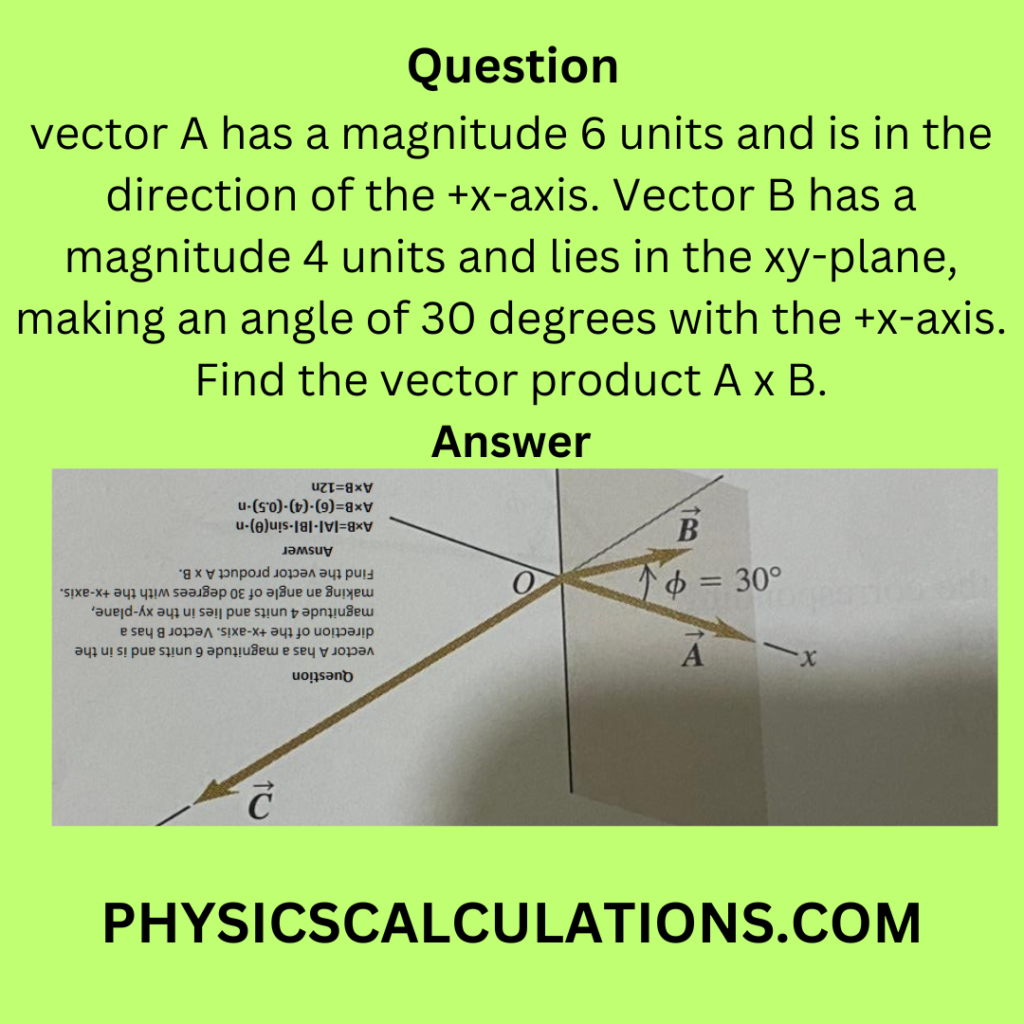Question
vector A has a magnitude 6 units and is in the direction of the +x-axis. Vector B has a magnitude 4 units and lies in the xy-plane, making an angle of 30 degrees with the +x-axis. Find the vector product A x B.
Answer
The vector product A×B of the two vectors A and B is equal to 12 times a unit vector n. This unit vector n is perpendicular to both A and B and follows the right-hand rule.

Here is how we arrived at the above answer:
Data:
Our goal is to find the vector product (A×B) of two vectors, A and B, given their magnitudes and orientations.
We have the following information:
- Vector A has a magnitude of 6 units and points in the direction of the +x-axis.
- Vector B has a magnitude of 4 units and lies in the xy-plane, making an angle of 30 degrees with the +x-axis.
Unknown:
We need to find the vector product A×B = ?
Formula:
To solve this problem, we’ll use the right-hand rule and the cross-product formula for the vector product (A×B):
A×B=∣A∣⋅∣B∣⋅sin(θ)⋅n
Where:
- ∣A∣ and ∣B∣ are the magnitudes of vectors A and B.
- θ is the angle between the two vectors.
- n is a unit vector perpendicular to both A and B, following the right-hand rule.
Solution:
First Step:
Let’s begin by identifying the given data:
- Magnitude of vector A (∣A∣) = 6 units.
- Magnitude of vector B (∣B∣) = 4 units.
- Vector B makes an angle of 30 degrees with the +x-axis.
Second Step:
We need to find the angle (θ) between vectors A and B. Since A is along the +x-axis and B makes an angle of 30 degrees with the +x-axis, θ=30 degrees.
Third Step:
We can apply the cross-product formula:
A×B=∣A∣⋅∣B∣⋅sin(θ)⋅n
Fourth Step:
Substitute the values:
A×B=(6)⋅(4)⋅sin(300)⋅n
Fifth Step: Calculate the sine of 30 degrees. You can use a calculator for this:
sin(300) =0.5
Sixth Step:
Now, we can calculate the result:
A×B=(6)⋅(4)⋅(0.5)⋅n
Therefore, we will now have:
A×B=12n
Explanation:
In this problem, we used the cross-product formula to find A×B, taking into account the magnitudes of the vectors, the angle between them, and the unit vector n. The unit vector n provides the direction of the resulting vector product.
This concept is fundamental in physics, particularly in the study of angular momentum, magnetic fields, and the behaviour of particles in electric and magnetic fields. The vector product allows us to determine the direction of the resultant vector when two vectors are crossed.
In summary, the vector product A×B of the two vectors A and B is equal to 12 times a unit vector n, following the right-hand rule. This vector product provides information about the orientation and direction of physical quantities in various physical scenarios, contributing to our understanding of complex systems and interactions.
You may also like to read:
Find the angle between the two vectors A = 2i + 3j + k, and B = -4i + 2j – k